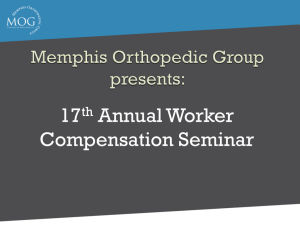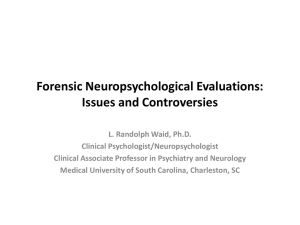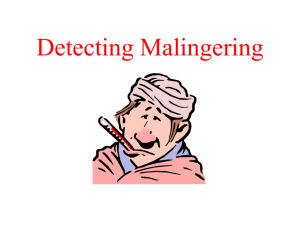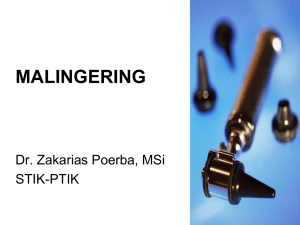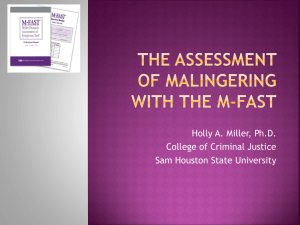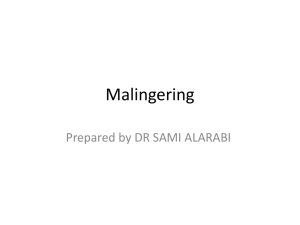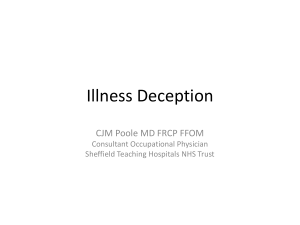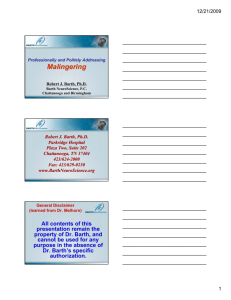Accepted Version (PDF 202kB)
advertisement
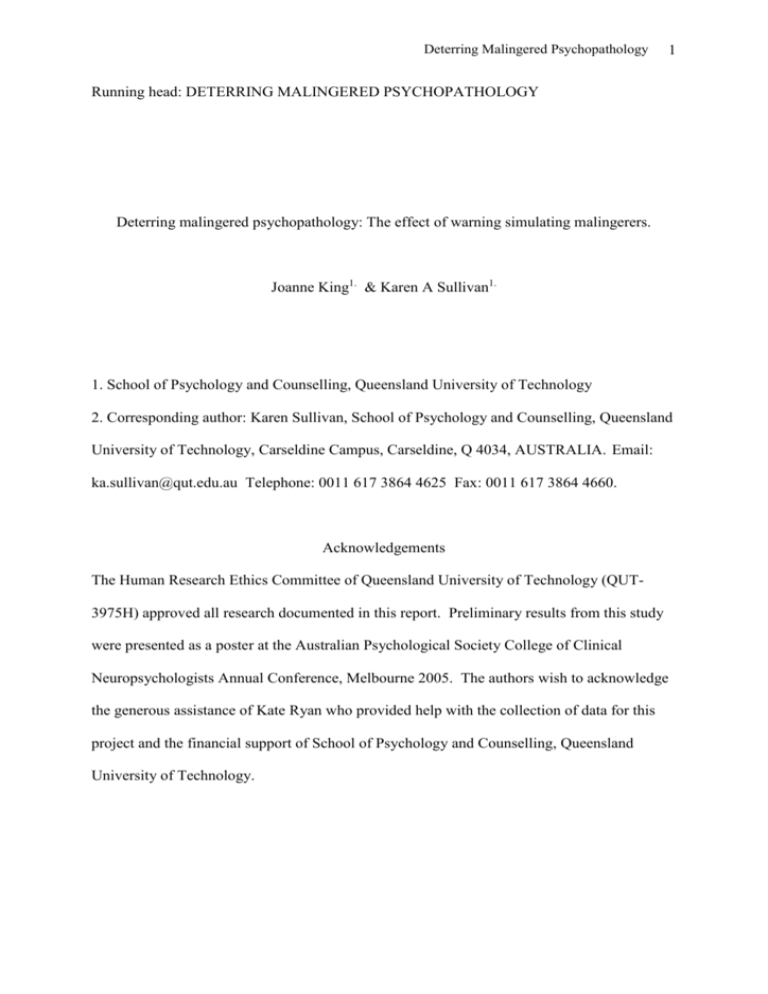
Deterring Malingered Psychopathology 1 Running head: DETERRING MALINGERED PSYCHOPATHOLOGY Deterring malingered psychopathology: The effect of warning simulating malingerers. Joanne King1. & Karen A Sullivan1. 1. School of Psychology and Counselling, Queensland University of Technology 2. Corresponding author: Karen Sullivan, School of Psychology and Counselling, Queensland University of Technology, Carseldine Campus, Carseldine, Q 4034, AUSTRALIA. Email: ka.sullivan@qut.edu.au Telephone: 0011 617 3864 4625 Fax: 0011 617 3864 4660. Acknowledgements The Human Research Ethics Committee of Queensland University of Technology (QUT3975H) approved all research documented in this report. Preliminary results from this study were presented as a poster at the Australian Psychological Society College of Clinical Neuropsychologists Annual Conference, Melbourne 2005. The authors wish to acknowledge the generous assistance of Kate Ryan who provided help with the collection of data for this project and the financial support of School of Psychology and Counselling, Queensland University of Technology. Deterring Malingered Psychopathology 2 Abstract The utility of a warning based on deterrence theory to deter malingering on measures of personality and psychopathology was examined. Sixty-seven first year psychology students were randomly assigned to one of three conditions: unwarned malingerers, warned malingerers and controls. Participants in the two malingering groups were given a financial incentive to simulate believable psychological impairment. Warned malingerers received an additional warning that the tests could detect malingering and that detection would result in loss of course credit. Controls received standardised test instructions. It was hypothesized that the malingering incentive would be sufficient to induce malingering, but that a deterrence theory warning would have a subsequent deterrent effect. Between-groups analyses indicated that the warning used in this study significantly altered test performance on the Personality Assessment Inventory (PAI) and revised Symptom Checklist 90 (SCL-90-R), such that warned malingerers scored significantly lower (faked less) than unwarned malingerers on the majority of the psychopathology scales and frequently approximated control group performances. These results support the effectiveness of a warning to complement existing malingering detection methods. Keywords: malingering, psychopathology, personality, faking bad, dissimulation. Deterring Malingered Psychopathology 3 Deterring malingered psychopathology: The effect of warning simulated malingerers. Malingering research to date has mostly focused on the construction and validation of detection methods (see Haines & Norris, 1995; Iverson & Binder, 2000; Slick, Sherman, & Iverson, 1999) with relatively little research into deterrent methods. However, malingering deterrents are important for several reasons. First, completely effective malingering detection methods are unlikely to be developed, despite the advent of increasingly sophisticated methods (Edens et al., 2001). Second, increased community awareness of the symptoms of common mental disorders (Lees-Haley & Dunn, 1994; Ruiz, Drake, Marcottee, Glass, & van Gorp, 2002; Steffan, Clopton, & Morgan, 2003) and the ease with which formal diagnostic criteria can be accessed, increase the risk of successful malingering. Furthermore, the possibility that some attorneys may undermine malingering detection by coaching their clients in taking psychological tests (Victor & Abeles, 2004; Wetter & Corrigan, 1995) also suggests that methods additional to detection may be needed to address malingering. Among studies of malingering deterrents, the most widely researched is the low-cost intervention of malingering warnings embedded within test instructions. Advancing our understanding of the efficacy of malingering warnings is important because verbal warnings are already used in some practical settings (Slick, Tan, Strauss, & Hultsch, 2004) and psychologists arguably have an ethical obligation to ensure clients have sufficient understanding of the nature and purpose of test procedures (Australian Psychological Society [APS], 2005), and this may include malingering assessment and the use of detection methods. Studies of warning methods have mostly concerned malingering of brain injury on neuropsychological tests (e.g., Erdal, 2004; Gunstad & Suhr, 2001; Johnson & LesniakKarpiak, 1997; Suhr & Gunstad, 2000). For example, Johnson and Lesniak-Karpiak (1997) assessed differences on the revised Wechsler memory scale (WMS-R) and speeded motor tasks, between malingerers with and without warning with respect to controls who were told Deterring Malingered Psychopathology 4 to perform optimally. Malingering was induced by a vignette describing participants’ involvement in a car accident and instructing them to believably fake head injury for a large financial gain. Warned simulators received an additional warning about simulation detection techniques. This group malingered less than simulators without warning on the WMS-R indexes of verbal memory, general memory and delayed recall, while no differences were found for visual memory and attention-concentration. Warned malingerers approximated control performance on speeded motor tasks. The findings of Johnson and colleagues, demonstrating selective warning effects, have been replicated in some (Erdal, 2004; Gunstad & Suhr, 2001; Johnson & Lesniak-Karpiak, 1997; Suhr & Gunstad, 2000) but not all warning studies. Other simulation studies have failed to produce any warning effect using measures of memory (Gunstad & Suhr, 2004; Slick, Hopp, Strauss, & Hunter, 1994; Sullivan, Keane, & Deffenti, 2001; Wong, LernerPoppen, & Durham, 1998), motor function (Wong et al., 1998), intelligence (Johnson, Bellah, Dodge, Kelley, & Livingston, 1998), or subjective complaints (Sullivan & Richer, 2002). There are several reasons that may account for the inconsistency in warning effects; the first of which relates to use of different warning methods across studies. Warning has previously been construed as a caution that tests may detect malingering. However, some studies have incorporated symptom coaching into warnings (e.g., Erdal, 2004) whilst others warn in the absence of coaching (e.g., Wong et al., 1998). Sullivan and Richer (2002) used warning terminology that included a context-specific deterrent motivator (i.e., prosecution for insurance fraud). Other methods have included specific advice on evading detection, such as avoiding major exaggeration (Erdal, 2004), or by encouraging detection avoidance such as warning one to be careful as the test is designed to catch fakers (i.e., Suhr & Gunstad, 2000). Providing a warning about a test’s ability to detect malingering and its resulting sanctions, and cautioning against detection or portraying evasion methods, may not produce the same Deterring Malingered Psychopathology 5 effects. In addition, use of warnings has also been largely restricted to a written format (e.g., Erdal, 2004; Gunstad & Suhr, 2001; Johnson & Lesniak-Karpiak, 1997; Suhr & Gunstad, 2000), even though this may differ from what occurs in clinical practice (Slick et al., 2004), and no previous warning studies have used bona fide sanctions against malingering. With one exception (Sullivan & Richer, 2002), warnings have not been designed using an explicit theoretical framework. This exception used a warning against malingering based on deterrence theory, which asserts that criminal behavior is preceded by a conscious evaluation of the costs and benefits derived from the behavior (Pogarsky, Piquero, & Paternoster, 2004). The theory states that the perceived criminal gain is compared to the perceived certainty, severity and celerity of the crime’s sanctions (Briscoe, 2004; Gibbs, 1975; Tittle, 1980; Zimring & Hawkins, 1973). Individuals are expected to refrain from offending if they perceive a high likelihood of detection and punishment, especially if severe and swiftly delivered (Gibbs, 1975; Zimring & Hawkins, 1973). Support for deterrence theory is found in studies of drunk-driving (Shore & Maguin, 1988); tax evasion (Klepper & Nagin, 1989); petty theft (Carmichael, Langton, Pendell, Reitzel, & Piquero, 2005; Paternoster, Saltzman, Waldo, & Chiricos, 1985); bad check-writing (Paternoster et al., 1985); vandalism and marijuana use (Carmichael et al., 2005). The rationale for using deterrence theory as the basis of this study, is that malingering is regarded in some contexts as fraud (Insurance Council of Australia, 2007) and fraud is a criminal act. Therefore, using a simulation design, the aim of this study was to investigate warning efficacy using tests of personality and psychopathology, a domain of functioning in which warning effects have not been examined previously, using a bone fide sanction delivered both verbally and in writing, that encouraged perceptions of high sanction certainty, severity and celerity, to encourage cost-benefit analyses of malingering and hence, deterrence. Perceptions of sanction certainty were further manipulated by the inclusion of factors intended to increase Deterring Malingered Psychopathology 6 malingerers’ confidence in their ability to malinger. Specifically, the use of measures of personality and psychopathology, which are widely regarded as more vulnerable to faking because of their greater reliance on self-report than performance-based neuropsychological tests (Aubrey, Dobbs, & Rule, 1989), and the requirement that simulators fake impairments with which they could be presumed to be familiar given the relatively high level of community awareness of symptoms associated with psychological disorders (Bagby, Nicholson, Bacchiochi, Ryder, & Bury, 2002; Lees-Haley, 1997), should increase simulating malingerers’ confidence in their ability to successfully fake mental illness and thereby increase the probability of significant deterrent effects. Operationally, it was expected that unwarned malingerers would score higher than both warned malingerers and controls on the clinical scales and malingering indexes of the Personality Assessment Inventory (PAI; Morey, 1991) and the revised Symptom Checklist 90 (SCL-90-R; Derogatis, 1992). No differences in clinical and malingering scores were expected between warned malingerers and controls. Method Participants Participants were 70 first-year psychology students enrolled at the Queensland University of Technology who received course credit for their participation. Of the 70 recruited participants, data from three of these was excluded because they did not follow malingering instructions as assessed by manipulation checks. Manipulation checks included a closed-ended question directly asking participants if they malingered and participants who failed to malinger when instructed, were excluded from the study, reducing the sample size to 67. A further two participants from the group of 21 warned malingerers, failed manipulation checks for one psychopathology measure only (i.e., only faked one measure but not the other when instructed to fake both). We retained their data for analyses on the test they faked, but otherwise excluded them. This exclusion resulted in a sample size of 20 unwarned Deterring Malingered Psychopathology 7 malingerers for analyses based on one test only, and a sample size of 19 for those analyses incorporating data from both tests1. The final sample comprised 48 (71.6%) females and 19 (28.4%) males. The mean age of participants was 26 years (SD = 10; range = 17 – 56 years). The majority of participants was from English-speaking backgrounds (86.6%) and had no history of mental illness (70.1%). There were no significant differences between experimental groups by age, F (2, 64) = 1.601, p >.05, sex, 2 (2, N = 67) = .519, p >.05, ethnicity, 2 (2, N = 67) = 2.447, p >.05, or psychological history, 2 (2, N = 67) = 2.251, p >.05. Measures Participants completed two measures of personality and psychopathology, the Personality Assessment Inventory (PAI; Morey, 1991) and the revised Symptom Checklist 90 (SCL-90-R; Derogatis, 1992). The PAI is a self-report inventory that measures a number of clinical and personality variables (Morey, 1991). The PAI includes 344-items, which are presented using a four-point nominal scale ranging from F (false, not at all true) to VT (very true). These items are used to generate twenty-two standard, non-overlapping scales comprising eleven clinical, two interpersonal, five treatment-related, and four validity scales. In addition to this, several research based indices have been developed for this test and two of these, both of which assess malingering (the Rogers Discriminant Function, RDF, Rogers et al., 1996 and the Malingering index (MAL), Morey, 1996), were also used in this study. The SCL-90-R is self-report screening test used to assess current psychopathology in psychiatric and medical patients (Derogatis, 1992). Ninety items are used to generate nine subscales comprising: somatization, obsessive-compulsive, interpersonal sensitivity, depression, anxiety, hostility, phobic anxiety, paranoid ideation and psychoticism. SCL-90-R items are presented on a five-point Likert scale ranging from 1 (not at all) to 5 (extremely), 1 Note: full exclusion of these two participants from all analyses did not alter the pattern of results. Deterring Malingered Psychopathology 8 such that higher scores indicate greater psychopathology. One of its three global distress indexes, the Positive Symptom Total (PST; Derogatis, 1992), developed to detect a dramatizing response style indicative of faking bad, was used in this study as an index of malingering. Procedure Participants were randomly allocated to one of three groups: Unwarned malingerers, warned malingerers, or controls. After providing informed consent and completing a demographic questionnaire, participants read an instructional-set specific to group membership. Unwarned malingerers were instructed to believably fake psychological impairment on the PAI and SCL-90-R for a chance to win $100. To facilitate this, they were given a list of characteristic disorder symptoms and were asked to familiarize themselves with these for a few minutes prior to testing. Rather than request participants fake specific disorders, we allowed participants to use symptom information in whatever way they wished to assist their faking. Participants were verbally reminded of the malingering incentive ($100) immediately prior to test-taking. Warned malingerers received identical instructions to unwarned malingerers with an additional warning that the measures could detect malingering and individuals detected would have their course credit for study participation revoked. These participants were verbally reminded of the malingering incentive immediately prior to test-taking, preceded by a verbal warning identical to that of the written warning. Control group participants received standard test instructions to perform optimally with compliance affording them a chance to win $1002. Participants then completed the PAI and SCL-90-R which were counterbalanced to control for order effects. Malingering index scores on the SCL-90-R and PAI were evaluated against relevant published standards (i.e., MAL, Morey, 1996; RDF, Rogers et al., 1996; SCL-90-R PST, Derogatis, 1992). 2 Note: In fact the $100 prize incentive was administered randomly from a pool comprising all participants. Despite participant instructions, the prize was not distributed based according to particular criteria; a fact about which participants were informed at debriefing. Deterring Malingered Psychopathology 9 Consistent with recommendations for research in this area (Edens et al., 2001; Nies & Sweet, 1994; Sullivan & Richer, 2002), participants completed a post-experimental questionnaire specific to group membership to assess understanding and compliance with instructions. Malingering outcome was assessed by a closed question directly asking participants if they malingered. Malingering strategy use was assessed qualitatively by asking both warned and unwarned participants to indicate strategies they used to fake believable deficits from a given list of strategies, in addition to an open-ended question affording them the opportunity to report their own alternative strategies. Participants were informed they were able to report more than one malingering strategy. The Human Research Ethics Committee of Queensland University of Technology (QUT-3975H) approved all research documented in this report. Because this study involved deception (i.e., there was the threat that warned malingerers, if detected, would have their course credit revoked), participants were debriefed. This debriefing included explanation of the deception. Course credit was not actually revoked from any of the study participants. Results Group Differences on the PAI Differences among the groups (i.e., unwarned malingerers, warned malingerers and controls) on the primary clinical scales of the PAI were examined using multivariate analysis of variance (MANOVA). A significant multivariate effect was found between groups on the 11 clinical scales, Pillai’s trace = .781, F (22, 108) = 3.15, p < .001, ղ2 = .391. Table 1 displays the PAI clinical scale means, standard deviations and results from univariate tests and pairwise comparisons for each individual clinical scale as a function of group membership. Univariate analyses (with Bonferoni correction to p <.004) demonstrated significant group differences on all clinical scales with the exception of mania, and antisocial features. Unwarned malingerers made little attempt to fake mania and antisocial features. Deterring Malingered Psychopathology 10 Pairwise comparisons indicated that warned malingerers produced significantly lower psychopathology scores than unwarned malingerers, and frequently approximating that of controls. There was an exception; warned malingerers scored significantly lower than unwarned malingerers but higher than controls on the depression scale. Together, these results largely established the effectiveness of the malingering instructional-set to induce malingering, and the utility of a warning to reduce malingering. [Table 1 about here] Group Differences on the SCL-90-R Differences among the three groups on the clinical scales of the SCL-90-R were examined using MANOVA and revealed significant multivariate effects, Pillai’s trace = .532, F (18, 112) = 2.25, p < .01, ղ2 = .266. Table 2 shows the SCL-90-R clinical scale means, standard deviations and results for each individual clinical scale as a function of group membership. Univariate analyses (with Bonferoni correction to p < .005) revealed significant group differences on all nine scales. Pairwise comparisons indicated warned malingerers scored significantly lower than unwarned malingerers, and no differently to controls on all clinical scales with the exception of obsessive-compulsive disorder (OCD). Although no significant differences emerged between warned and unwarned simulators on OCD, differences were in the expected direction, demonstrating the efficacy of the malingering incentive to induce malingering and the efficacy of a subsequent warning to reduce faking. [Table 2 about here] Group Differences on the Malingering Indexes Group differences for the three malingering indexes of the PAI (NIM, MAL, RDF) were examined using MANOVA. An omnibus multivariate effect was present, Pillai’s trace = .488, F (6, 122) = 6.57, p < .001, ղ2 = .24. Table 3 displays the means, standard deviations and univariate results for the PAI and SCL-90-R individual malingering index scales as a Deterring Malingered Psychopathology 11 function of group membership. Univariate analyses (with Bonferoni correction for PAI scales to p <.0167) revealed significant group differences on all malingering indexes. Warned malingerers scored significantly lower than unwarned malingerers, and no differently to controls on all indexes. [Table 3 about here] The percent correct classification across groups using standard cut-offs for the NIM, MAL, RDF, and PST was also examined. The results of this analysis (see Table 4) showed that most controls were correctly classified as non-malingerers (>% 80 on three of the four malingering indices). Most warned malingerers were classified as non-malingerers but classifications were variable, ranging from 67% for the PST to 96% for the MAL. The RDF correctly classified almost 90% of participants in the malingerer condition as malingerers, but the performance of other malingering indices was much less than this number. [Table 4 about here] As a further check on results, the analyses of the effect of group on PAI and SCL-90R scores was reexamined using the most accurate of the standard cut-offs to define groups rather than experimental conditions (the RDF). The results of these analyses were largely identical to those reported above. That is, the overall PAI and SCL-90-R MANOVAs with group defined by RDF (malingering versus non-malingering) were significant, and the pattern of subtest differences was identical in 10 of the 11 PAI subtests, and all of the SCL-90-R subtests. The subtest that was different was the paranoia subscale of the PAI. When experimental group was used as the independent variable in the PAI MANOVA, significant differences between the three conditions (controls, warned and unwarned) were noted as shown in Table 1, but no such differences were evident when groups were defined by RDF status (as malingerer versus non-malingerer). Malingering Strategies Deterring Malingered Psychopathology 12 Qualitative results pertaining to strategy use are shown in Figure 1. Where participants reported multiple strategies (N = 11), each reported strategy was counted separately. Reliance on disorder knowledge was the most common strategy used by malingerers to fake believable deficits. Other less reported strategies included not reporting extreme, bizarre or unusual symptoms, attempting to report symptoms that appeared normal, and generally taking a conservative approach to symptom reporting. In general the strategies reported by unwarned malingerers and those that faked despite the warning were similar: the most popular strategy was the same for both groups; and, this ‘popular’ strategy was endorsed by a similar and relatively large proportion (approximately 70%) of the participants in each group. [Figure 1 about here] Discussion This simulation study assessed the utility of a warning based on deterrence theory to deter malingering on measures of personality and psychopathology. The hypothesis that a relatively weak incentive and malingering instructional set would be sufficient to induce malingering was supported. Unwarned participants instructed to fake psychological impairment for the opportunity to win a financial reward, reported significantly greater psychopathology than controls. This finding is consistent with previous research demonstrating the ease with which malingering may be induced based on hypothetical incentives (Erdal, 2004; Sullivan & Richer, 2002; Wong et al., 1998) or bona fide financial inducements (Sullivan, Keane, & Deffenti, 2001). These results reinforce the notion that real external incentives offered to bona fide malingerers would, in comparison, be strong malingering motivators. These results also highlight the vulnerability of personality and psychopathology measures to malingering and emphasize the need for both deterrence and detection methods in conjunction with these measures. Deterring Malingered Psychopathology 13 The Utility of Warning to Deter Malingering A warning based on deterrence theory and utilizing a bona fide sanction, reduced malingering on measures of personality and psychopathology. The hypothesis that warned malingerers would score significantly lower than unwarned malingerers, and no differently to controls on the PAI, SCL-90-R and their respective malingering indexes, was largely supported. All malingering indexes, and 17 of the 18 psychopathology scales where malingering was successfully induced, showed an impact of warning, with one scale demonstrating partial support for a warning effect. This finding is consistent with studies supporting the utility of warning to reduce malingering on neuropsychological measures (Erdal, 2004; Gunstad & Suhr, 2001; Johnson & Lesniak-Karpiak, 1997; Suhr & Gunstad, 2000), and faking good on personality inventories (Braun & Faro, 1968; Nias, 1972). The use of a theoretically-informed warning method and a bona fide sanction in this study may help explain why previous research has sometimes failed to find a warning effect (Johnson et al., 1998; Slick et al., 1994; Suhr et al., 2004; Sullivan et al., 2001; Wong et al., 1998). The finding that the effects of warning extended to most scales on both measures and to all malingering indexes, differs somewhat to past neuropsychological warning research that has found warning to have a more selective and differential effect across measures. For instance, Johnson and Lesniak-Karpiak (1997) found warning effective on three of five WMS-R memory indexes, whilst Erdal (2004) found that warning reduced malingering on the DCT but not on the Rey FIT, even though these tests measure similar constructs. The relatively robust and less differentiated warning effect found in the present study suggests that the warning method may account for much of the variation in warning effects found in previous studies. In addition, warning may be more effective for personality and psychopathology measures than neuropsychological measures, supporting the notion that specific tests, abilities or contexts influence warning efficacy (Sullivan & Richer, 2002). It is Deterring Malingered Psychopathology 14 also possible that the certainty of detection may have been perceived as lower when faking psychopathology compared to neuropsychological disorders because of greater community awareness of the former (Bagby et al., 2002; Lees-Haley, 1997), although this requires further investigation. Furthermore, although speculative, participants may presume that measures of personality and psychopathology include malingering detection capacities whilst similar devices may not be assumed to exist in neuropsychological measures because these are less well known. These results suggest that a warning method based on deterrence theory, incorporating a bona fide sanction and delivered both verbally and in writing, can increase the size of the warning effect. However, it is not clear from this study whether all of these components are necessary. Hence more work is needed to identify the optimal content and delivery forms for malingering warnings. Overall the warning effect was robust in this study, yet there were two anomalies. Warned malingerers faked significantly less depression on the PAI than unwarned malingerers, yet they faked significantly more than controls. This effect was not observed for depression on the SCL-90-R. Additionally, warned malingerers scored no differently to controls or unwarned malingerers for OCD on the SCL-90-R. Again, this effect was not observed for OCD (anxiety related disorders scale [ARD]) on the PAI. As these effects were not consistently observed in both the PAI and the SCL-90-R, they may be linked to scale properties rather than reflect the nature of the underlying psychopathologies. The finding that potential malingerers were deterred by a relatively weak deterrent, suggests that warnings which successfully communicate sanctions to bona fide malingerers may reduce malingering on measures of personality and psychopathology, particularly in those who lack awareness of detection consequences. These results do not imply that detection methods be substituted by warnings. It is likely that warnings will never deter all malingering and detection methods remain the best defense, especially when multiple Deterring Malingered Psychopathology 15 indicators are used and interpreted carefully (Iverson & Binder, 2000). However, the warning method investigated here may help to deter individuals from malingering on measures of personality and psychopathology. Further, without good malingering detection on measures, warnings would become ineffective over time as individuals learn that tests are unable to effectively detect malingering. In this respect, the validity and subsequent utility of a warning remains dependent on the detection capabilities of the measures concerned. Limitations and conclusions There are several important limitations of this study. It is unknown whether findings derived from undergraduate student simulators may generalize to actual malingerers who may have stronger malingering motivations. The use of samples in which bona fide malingers are likely to be present, or samples more representative of the populations of interest, such as inmates, psychiatric patients, compensation claimants, or welfare recipients may provide more generalizable results. A further limitation of this study was the lack of a clinical control group. Little is known about how comparing malingerers to well individuals as opposed to a clinical population, might influence the group differences between malingerers and controls. Whilst the use of a simulation design is an acknowledged limitation, simulation designs can provide valuable results because the actual status of malingerers is known. Additionally, the use of student samples has proven viable with students demonstrating more sophisticated malingering than clinical simulators (Haines & Norris, 2001). The idea of incorporating warnings in clinical practice raises several issues. Whilst such practice is recommended (Iverson, 2006) and North American surveys suggest that between one quarter (Slick et al., 2004) and one third (Sharland & Gfeller, 2007) of clinicians already “often or always” use warnings prior to testing, the effect of warnings on genuine clients must be considered. The present study did not address this issue; however, in previous work we have shown that warnings do not alter the performance of participants who are trying Deterring Malingered Psychopathology 16 to perform at the best of their ability, at least when memory tests are used (Sullivan, Deffenti, & Keane, 2002). On that basis, it seems reasonable to suggest that warnings will not adversely impact the performance of genuine test-takers, although further research is needed. On the question of whether or not malingerers become more sophisticated when they received a warning, we have argued that warnings appear to deter some (up to 70%) but not all malingerers; and, based on our preliminary data on strategy use, similar strategies were reported by those who faked whether or not they received a warning. We cannot rule out the possibility that the few participants that faked despite warning (30% of the warned group) did so in a more sophisticated manner than if they had they not been warned. Until we are able to tease out these issues further, perhaps by conducting a closer examination of strategy use, it remains possible that warnings have both a deterrent effect (perhaps on the majority of people who receive them) as well as an effect on the strategies used by those who fake despite warnings. Deterring Malingered Psychopathology 17 References American Psychiatric Association. (2000). Diagnostic and statistical manual of mental disorders (4th ed., text rev.). Washington, DC: Author. Aubrey, J. B., Dobbs, A. R., & Rule, B. G. (1989). Laypersons’ knowledge about the sequelae of minor head injury and whiplash. Journal of Neurology, Neurosurgery, and Psychiatry, 52, 842-846. Australian Psychological Society. (2005). Code of ethics. Victoria: The Australian Psychological Society Limited. Bagby, R., Nicholson, R., Bacchiochi, J., Ryder, A., & Bury, A. (2002). The predictive capacity of the MMPI-2 and the PAI validity scales and indexes to detect coached and uncoached feigning. Journal of Personality Assessment, 78, 69-86. Braun, J., & Faro, D. (1968). Effects of salesman faking instructions on the contact personality factor test. Psychological Reports, 22, 1245-1248. Briscoe, S. (2004). Raising the bar: Can increased statutory penalties deter drink-drivers? Accident Analysis and Prevention, 36, 919-929. Carmichael, S., Langton, L., Pendell, G., Reitzel, J., & Piquero, A. (2005). Do the experiential and deterrent effect operate differently across gender? Journal of Criminal Justice, 33, 267-276. Clifford, D., Byrne, K., & Allan, C. (2004). Getting caught in court: Base rates for malingering in Australasian litigants. Psychiatry, Psychology and Law, 11, 197-201. Derogatis, L. (1992). SCL-90-R: Administration, scoring and procedures manual II for the revised version. Towson, MD: Clinical Psychometric Research. Edens, J. F., Guy, L. S., Otto, R. K., Buffington, J. K., Tomicic, T. L., & Poythress, N. G. (2001). Factors differentiating successful versus unsuccessful malingerers. Journal of Personality Assessment, 77, 333-338. Deterring Malingered Psychopathology 18 Erdal, K. (2004). The effects of motivation, coaching, and knowledge of neuropsychology on the simulated malingering of head injury. Archives of Clinical Neuropsychology, 19, 73-88. Gibbs, J. (1975). Crime, punishment and deterrence. New York: Elsevier Scientific Publishing Company. Gunstad, J., & Suhr, J. (2001). Courting the clinician: Efficacy of the full and abbreviated forms of the Portland digit recognition test: Vulnerability to coaching. The Clinical Neuropsychologist, 15, 397-404. Gunstad, J., & Suhr, J. (2004). Use of the abbreviated Portland digit recognition test in simulated malingering and neurological groups. Journal of Forensic Neuropsychology, 4, 33-47. Haines, M. E., & Norris, M. P. (1995). Approaches to the detection of malingering of cognitive deficits: A critical review. Neuropsychology Review, 5, 125-148. Haines, M., & Norris, M. (2001). Comparing student and patient simulated malingers’ performance on standard neuropsychological measures to detect feigned cognitive deficits. The Clinical Neuropsychologist, 15, 171-182. Insurance Australia Group, & Economist Intelligence Unit. (n.d.). Hidden costs: Insurance fraud in Australia. Retrieved March 21, 2007, from http://www.iag.com.au/pub/iag/results/submissions/media/20041119a.pdf Iverson, G. (2006). Ethical Issues Associated With the Assessment of Exaggeration, Poor Effort, and Malingering. Applied Neuropsychology, 13, 77–90. Iverson, G. L., & Binder, L. M. (2000). Detecting exaggeration and malingering in neuropsychological assessment. Journal of Head Trauma Rehabilitation, 15, 829-858. Johnson, J., Bellah, C., Dodge, T., Kelley, W., & Livingston, M. (1998). Effect of warning on feigned malingering on the WAIS-R in college samples. Perceptual and Motor Skills, Deterring Malingered Psychopathology 19 87, 152-154. Johnson, J., & Lesniak-Karpiack, K. (1997). The effect of warning on malingering on memory and motor tasks in college samples. Archives of Clinical Neuropsychology, 12, 231-238. Klepper, S., & Nagin, D. (1989). Tax compliance and perceptions of the risks of detection and criminal prosecution. Law and Society Review, 23, 209-240. Lees-Haley, P. R. (1997). MMPI-2 base rates for 492 personal injury plaintiffs: Implications and challenges for forensic assessment. Journal of Clinical Psychology, 53, 745-755. Lees-Haley, P. R., & Dunn, J. (1994). The ability of naïve subjects to report symptoms of mild brain injury, post-traumatic stress disorder, major depression, and generalized anxiety disorder. Journal of Clinical Psychology, 50, 252-256. Mittenberg, W., Patton, C., Canyock, E., & Condit, D. (2002). Base rates of malingering and symptom exaggeration. Journal of Clinical and Experimental Neuropsychology. 24, 1094- 1102. Morey, L. (1991). Personality assessment inventory: Professional manual. Florida: Psychological Assessment Resources. Morey, L. (1996). An interpretive guide to the personality assessment inventory (PAI). Odessa, FL: Psychological Assessment Resources. Nias, D. (1972). The effects of providing a warning about the lie scale in a personality inventory. British Journal of Educational Psychology, 42, 308-312. Nies, K. J., & Sweet, J. J. (1994). Neuropsychological assessment and malingering: A critical review of past and present strategies. Archives of Clinical Neuropsychology, 9, 501552. Paternoster, R., Saltzman, L., Waldo, G., & Chiricos, T. (1985). Assessment of risk and behavioural experience: An exploratory study of change. Criminology, 23, 417-436. Deterring Malingered Psychopathology 20 Pogarsky, G., Piquero, A. R., & Paternoster, R. (2004). Modeling change in perceptions about sanction threats: The neglected linkage in deterrence theory. Journal of Quantitative Criminology, 20, 343-369. Rogers, R., Sewell, K., Morey, L., & Ustad, K. (1996). Detection of feigned mental disorders on the personality assessment inventory: A discriminant analysis. Journal of Personality Assessment, 67, 629-640. Ruiz, M., Drake, E., Marcottee, D., Glass, A., & van Gorp, W. (2002). Trying to beat the system: Misuse of the internet to assist in avoiding the detection of neuropsychological symptom dissimulation. Archives of Clinical Neuropsychology, 8, 846. Sbordone, R. J., Syeranian, G. D., & Ruff, R. M. (2000). The use of significant others to enhance the detection of malingerers from traumatically brain-injured patients. Archives of Neuropsychology, 15, 465-477. Sharland, M. J. & Gfeller, J. D. (2007). A survey of neuropsychologists’ beliefs and practices with respect to the assessment of effort. Archives of Clinical Neuropsychology, 22, 213-223. Shore, E., & Maguin, E. (1988). Deterrence of drink-driving: The effects of changes in the Kansas driving under the influence law. Evaluation and Program Planning, 11, 245254. Slick, D., Hopp, G., Strauss, E., & Hunter, M. (1994). Detecting dissimulation: Profiles of simulated malingerers, traumatic brain-injury patients, and normal controls on a revised version of Hiscock and Hiscock’s forced-choice memory test. Journal of Clinical and Experimental Neuropsychology, 16, 472-481. Slick, D. J., Sherman, E. M. S., & Iverson, G. L. (1999). Diagnostic criteria for malingered neurocognitive dysfunction: Proposed standards for clinical practice and research. The Deterring Malingered Psychopathology 21 Clinical Neuropsychologist, 13, 545-561 Slick, D., Tan, J., Strauss, E., & Hultsch, D. (2004). Detecting malingering: A survey of experts’ practices. Archives of Clinical Neuropsychology, 19, 465-473. Steffan, J. S., Clopton, J. R., Morgan, R. D. (2003). An MMPI-2 scale to detect malingered depression (Md scale). Assessment, 10, 382-392. Suhr, J., & Gunstad, J. (2000). The effects of coaching on the sensitivity and specificity of malingering measures. Archives of Clinical Neuropsychology, 15, 415-424. Sullivan, K., Keane, B., & Deffenti, C. (2001). Malingering on the RAVLT part 1: Deterrence strategies. Archives of Clinical Neuropsychology, 16, 627-641. Sullivan, K, Lange, R. T., & Dawes, S. (in press). Symptom exaggeration base rates and detection methods in Australia, Archives of Clinical Neuropsychology. Sullivan, K., & Richer, C. (2002). Malingering on subjective complaint tasks. An exploration of the deterrent effects of warning. Archives of Clinical Neuropsychology, 17, 691708. Tittle, C. (1980). Sanctions and social deviance. New York: Praeger. Victor, T., & Abeles, N. (2004). Coaching clients to take psychological and neuropsychological tests: A clash of ethical obligations. Professional Psychology, Research and Practice, 35, 373-379. Wetter, M., & Corrigan, S. (1995). Providing information to clients about psychological tests: A survey of attorneys’ and law students’ attitudes. Professional Psychology, Research and Practice, 26, 474-477. Wong, J., Lerner-Poppen, L., & Durham, J. (1998). Does warning reduce obvious malingering on memory and motor tasks in college samples? International Journal of Rehabilitation and Health, 4, 153-165. Zimring, F., & Hawkins, G. (1973). Deterrence: The legal threat in crime control. Deterring Malingered Psychopathology 22 Chicago:University of Chicago Press. Deterring Malingered Psychopathology 23 Table 1. Malingering on the PAI: Means, Standard Deviations, Pooled Within Groups Correlations, and Group Differences ______________________________________________________________________________________________________________________ Controls Warned Unwarned (n = 22) (n = 24) (n = 20) Scale M 1.SOM 56.38a 11.22 62.00a 15.94 105.84b 34.18 31.35* 2.ANX 51.05a 9.55 58.80a 14.05 82.65 b 17.56 28.84* 3.ARD 51.22a 10.05 58.50a 18.01 82.29 b 19.58 20.50* 4.DEP 50.24a 10.09 66.76b 19.46 92.57 c 23.18 28.41* 5.MAN 51.36a 12.24 45.30a 7.42 56.69 a 18.62 6.PAR 50.42a 9.49 59.39a 20.11 86.38 b 23.00 21.07* 7.SCZ 50.02a 9.79 63.53a 20.42 89.08 b 24.25 22.65* 8.BOR 50.38a 8.19 56.84a 12.61 71.46 b 16.95 14.52* 9.ANT 51.72a 9.63 51.42a 10.58 61.80 a 20.38 3.72 10.ALC 50.90a 8.94 55.95a 13.73 71.95 b 22.87 9.92* 10.57 60.28a 20.37 92.50 b 31.15 18.63* 11.DRG 53.72a SD M SD M SD F(2,63) 4.09 1 2 3 4 5 6 7 8 9 10 11 1.00 .74 .75 .71 .48 .78 .76 .69 .58 .56 .62 1.00 .84 .71 .32 .74 .84 .67 .34 .29 .41 1.00 .75 .34 .80 .83 .69 .48 .37 .46 1.00 .21 .77 .80 .78 .39 .39 .46 1.00 .35 .38 .47 .68 .40 .27 1.00 .87 .75 .56 .42 .45 1.00 .80 .53 .40 .45 1.00 .63 .56 .46 1.00 .59 .59 1.00 .73 1.00 Note. PAI = Personality Assessment Inventory; SOM = Somatic Complaints; ANX = Anxiety; ARD = Anxiety Related Disorders; DEP = Depression; MAN = Mania; PAR = Paranoia; SCZ = Schizophrenia; BOR = Borderline Features; ANT = Antisocial Features; ALC = Alcohol Problems; DRG = Drug Problems. Means represent T-scores (M = 50, SD = 10) with a T-score at or above 70 representing 2 SDs from the nonclinical college student standardisation sample. Means in the same row that do not share subscripts differ significantly at p < .004 using Bonferroni correction. *p < .001. Deterring Malingered Psychopathology 24 Table 2 Malingering on the SCL-90-R: Means, Standard Deviations, Pooled Within Groups Correlations, and Group Differences ______________________________________________________________________________________________________________________ Scale Controls Warned Unwarned (n = 22) (n = 24) (n = 20) M SD M SD M SD F(2,63) 1.SOM 60.27a 19.60 61.23a 17.50 91.65b 30.57 12.77* 2.O-C 65.19a 17.84 74.85a&b 21.20 90.10b 22.25 7.84* 3.IS 72.55a 21.55 71.26 a 25.96 102.94b 31.25 9.69** 4.DEP 6603 a 20.18 72.68 a 24.84 96.08 b 27.76 8.72** 5.ANX 60.32a 24.97 67.11 a 22.61 101.79b 30.88 15.09** 6.HOS 63.99a 19.83 64.90 a 20.56 87.62 b 7.PHOB 57.01a 27.79 64.22 a 37.68 104.41b 45.00 9.79** 8.PAR 62.09a 19.29 61.62 a 23.13 89.49 b 31.00 8.74* 9.PSY 72.74a 37.47 75.71 a 37.34 124.82b 49.81 10.34* 31.24 6.45* 1 2 3 4 5 6 7 8 9 1.00 .72 .64 .69 .83 .66 .67 .66 .69 1.00 .75 .76 .79 .73 .61 .74 .74 1.00 .80 .83 .65 .79 .81 .76 1.00 .77 .67 .67 .69 .71 1.00 .72 .87 .81 .85 1.00 .57 .75 .69 1.00 .74 .73 1.00 .80 1.00 Note. SCL-90-R = Symptom Checklist-90 Revised; SOM = Somatisation; O-C = Obsessive-Compulsive; I-S = Interpersonal Sensitivity; DEP = Depression; ANX = Anxiety; HOS = Hostility; PHOB = Phobic Anxiety; PAR = Paranoid Ideation; PSY = Psychoticism. Means represent scale T-scores (M = 50, SD = 10) with a T-score at or above 70 representing a pronounced deviation (2 SDs) from the nonclinical standardisation sample. Means in the same row that do not share subscripts differ significantly at p < .005 using Bonferonni correction. *p < .005 **p < .001. Deterring Malingered Psychopathology 25 Table 3 Performance on the Malingering Indexes: Means, Standard Deviations, Pooled Within Groups Correlations, Effect Sizes, and Group Differences ______________________________________________________________________________________________________________________ Scale Controls Warned Unwarned (n = 22) (n = 24) (n = 19a) M SD M SD M SD F(2,62) db 1 2 3 4 PAI 1.NIM 52.89a 9.95 63.83 a 21.28 97.97 b 38.61 17.51** 1.70 2.MAL .82 a .91 1.00 a 1.50 2.68 b 1.95 9.60** 1.29 3.RDF .92 a 1.52 -.45 a 1.61 1.76 b 1.43 17.58** 1.86 43.42 a 21.48 66.95 b 25.58 7.05* .96 1.00 .75 .29 .47 1.00 .31 .39 1.00 .42 SCL-90-R 4.PST 42.55 a 23.44 1.00 Note. NIM = Negative Impression Management Scale (PAI; ≥ 92T = malingering); MAL = Malingering Index (PAI; ≥ 5 = malingering); RDF = Roger’s Discriminant Function Index (PAI; > .12368 = malingering); PST = Positive Symptom Total (SCL-90-R; > 50 males, > 60 females = malingering). The cutoffs listed are original recommended cutoffs by test authors. Means in the same row that do not share subscripts differ significantly at p < .0125 using Bonferonni correction. a The two partially-excluded participants were omitted from this analysis to permit comparison across malingering indexes. Cohen’s d = effect sizes for unwarned malingerers versus controls. b *p < .01. **p < .001. Deterring Malingered Psychopathology 26 Table 4 Percent Correct Classification as Non-malingerer Across Three Experimental Groups (Controls, Warned Malingerers and Malingerers) Using standard Cut-Offs for Four Malingering Indices. Controls (n = 22) Warned (n = 24) Unwarned (n = 19a) NIM 100 92 52 MAL 100 96 74 RDF 82 71 11 PST 68 67 32 Note. NIM = Negative Impression Management Scale (PAI; ≥ 92T = malingering); MAL = Malingering Index (PAI; ≥ 5 = malingering); RDF = Roger’s Discriminant Function Index (PAI; > .12368 = malingering); PST = Positive Symptom Total (SCL-90-R; > 50 males, > 60 females = malingering). The cutoffs listed are original recommended cutoffs by test authors. a The two partially-excluded participants were omitted from this analysis to permit comparison across malingering indexes.
